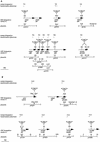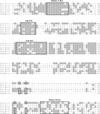Molecular analyses of the natural transformation machinery and identification of pilus structures in the extremely thermophilic bacterium Thermus thermophilus strain HB27
- PMID: 11823215
- PMCID: PMC126729
- DOI: 10.1128/AEM.68.2.745-755.2002
Molecular analyses of the natural transformation machinery and identification of pilus structures in the extremely thermophilic bacterium Thermus thermophilus strain HB27
Abstract
Thermus thermophilus HB27, an extremely thermophilic bacterium, exhibits high competence for natural transformation. To identify genes of the natural transformation machinery of T. thermophilus HB27, we performed homology searches in the partially completed T. thermophilus genomic sequence for conserved competence genes. These analyses resulted in the detection of 28 open reading frames (ORFs) exhibiting significant similarities to known competence proteins of gram-negative and gram-positive bacteria. Disruption of 15 selected potential competence genes led to the identification of 8 noncompetent mutants and one transformation-deficient mutant with a 100-fold reduced transformation frequency. One competence protein is similar to DprA of Haemophilus influenzae, seven are similar to type IV pilus proteins of Pseudomonas aeruginosa or Neisseria gonorrhoeae (PilM, PilN, PilO, PilQ, PilF, PilC, PilD), and another deduced protein (PilW) is similar to a protein of unknown function in Deinococcus radiodurans R1. Analysis of the piliation phenotype of T. thermophilus HB27 revealed the presence of single pilus structures on the surface of the wild-type cells, whereas the noncompetent pil mutants of Thermus, with the exception of the pilF mutant, were devoid of pilus structures. These results suggest that pili and natural transformation in T. thermophilus HB27 are functionally linked.
Figures




Similar articles
-
Pilin-like proteins in the extremely thermophilic bacterium Thermus thermophilus HB27: implication in competence for natural transformation and links to type IV pilus biogenesis.Appl Environ Microbiol. 2003 Jul;69(7):3695-700. doi: 10.1128/AEM.69.7.3695-3700.2003. Appl Environ Microbiol. 2003. PMID: 12839734 Free PMC article.
-
Identification, subcellular localization and functional interactions of PilMNOWQ and PilA4 involved in transformation competency and pilus biogenesis in the thermophilic bacterium Thermus thermophilus HB27.FEBS J. 2006 Jul;273(14):3261-72. doi: 10.1111/j.1742-4658.2006.05335.x. FEBS J. 2006. PMID: 16857013
-
Natural transformation in mesophilic and thermophilic bacteria: identification and characterization of novel, closely related competence genes in Acinetobacter sp. strain BD413 and Thermus thermophilus HB27.Appl Environ Microbiol. 2001 Jul;67(7):3140-8. doi: 10.1128/AEM.67.7.3140-3148.2001. Appl Environ Microbiol. 2001. PMID: 11425734 Free PMC article.
-
Type IV Pili in Thermophilic Bacteria: Mechanisms and Ecological Implications.Biomolecules. 2025 Mar 21;15(4):459. doi: 10.3390/biom15040459. Biomolecules. 2025. PMID: 40305182 Free PMC article. Review.
-
Shuffling genes around in hot environments: the unique DNA transporter of Thermus thermophilus.FEMS Microbiol Rev. 2009 May;33(3):611-26. doi: 10.1111/j.1574-6976.2008.00160.x. Epub 2009 Jan 16. FEMS Microbiol Rev. 2009. PMID: 19207744 Review.
Cited by
-
Unusual N-terminal ααβαββα fold of PilQ from Thermus thermophilus mediates ring formation and is essential for piliation.J Biol Chem. 2012 Mar 9;287(11):8484-94. doi: 10.1074/jbc.M111.334912. Epub 2012 Jan 17. J Biol Chem. 2012. PMID: 22253437 Free PMC article.
-
The Diversity of Bacteriophages in Hot Springs.Methods Mol Biol. 2024;2738:73-88. doi: 10.1007/978-1-0716-3549-0_4. Methods Mol Biol. 2024. PMID: 37966592 Review.
-
Genetic tool development underpins recent advances in thermophilic whole-cell biocatalysts.Microb Biotechnol. 2011 Jul;4(4):438-48. doi: 10.1111/j.1751-7915.2010.00246.x. Epub 2011 Feb 10. Microb Biotechnol. 2011. PMID: 21310009 Free PMC article. Review.
-
Sequence of the 165-kilobase catabolic plasmid pAO1 from Arthrobacter nicotinovorans and identification of a pAO1-dependent nicotine uptake system.J Bacteriol. 2003 Mar;185(6):1976-86. doi: 10.1128/JB.185.6.1976-1986.2003. J Bacteriol. 2003. PMID: 12618462 Free PMC article.
-
DNA transport and natural transformation in mesophilic and thermophilic bacteria.J Bioenerg Biomembr. 2004 Feb;36(1):25-33. doi: 10.1023/b:jobb.0000019595.66733.fa. J Bioenerg Biomembr. 2004. PMID: 15168607 Review.
References
-
- Aravind, I., R. L. Tatusov, Y. I. Wolf, D. R. Walker, and E. V. Koonin. 1998. Evidence for massive gene exchange between archaeal and bacterial hyperthermophiles. Trends Genet. 14:442-444. - PubMed
-
- Beckeral, H. D., B. Minal, C. Jacobib, G. Raczniaka, J. Pelaschiera, H. Royc, S. Kleinc, D. Kernc, and D. Sollad. 2000. The heterotrimeric Thermus thermophilus asp-tRNA (Asn) amidotransferase can also generate gln-tRNA. FEBS Lett. 476:140-144. - PubMed
-
- Bhaya, D., N. R. Bianco, D. Bryant, and A. Grossman. 2000. Type IV pilus biogenesis and motility in the cyanobacterium Synechocystis sp. PCC6803. Mol. Microbiol. 37:941-9951. - PubMed
-
- Brock, T. D. 1994. Genus Thermus Brock and Freeze 1969, 295AL, p. 333. In N. R. Krieg and J. G. Holt (ed.), Bergey's manual of systematic bacteriology, vol. 1. Williams & Wilkins, Baltimore, Md.
Publication types
MeSH terms
Associated data
- Actions
- Actions
- Actions
- Actions
- Actions
LinkOut - more resources
Full Text Sources
Other Literature Sources
Molecular Biology Databases

